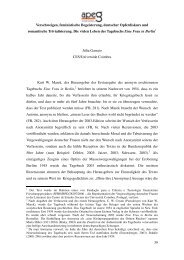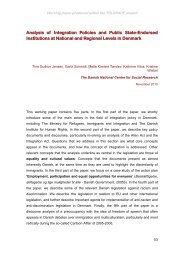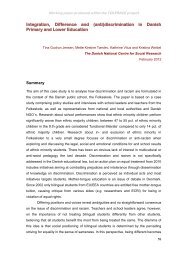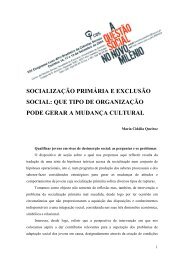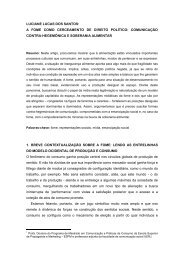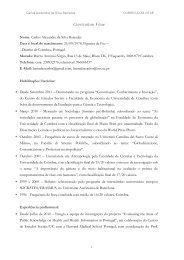The Instrumentalization of Sexual Violence in German Cold War Anti ...
The Instrumentalization of Sexual Violence in German Cold War Anti ...
The Instrumentalization of Sexual Violence in German Cold War Anti ...
Create successful ePaper yourself
Turn your PDF publications into a flip-book with our unique Google optimized e-Paper software.
RCCS Annual Review, 5, October 2013<br />
<strong>The</strong> <strong>Instrumentalization</strong> <strong>of</strong> <strong>Sexual</strong> <strong>Violence</strong> <strong>in</strong> <strong>German</strong> <strong>Cold</strong> <strong>War</strong> <strong>Anti</strong>-Communist Discourses<br />
foundations for a better Christian future for both <strong>German</strong>s and Slavs” (ibidem: 23). This<br />
desire to rechristianize Europe also had <strong>in</strong> m<strong>in</strong>d certa<strong>in</strong> social practices <strong>of</strong> the Federal<br />
Republic <strong>of</strong> <strong>German</strong>y. In his <strong>in</strong>troduction, Bishop Ferche writes that the sacrifices recounted<br />
<strong>in</strong> the book should be held up as an example at a time when so many <strong>German</strong> women lightly<br />
risked their honor (ibidem: 8). Throughout the text it becomes more and more obvious that<br />
re-Christianization is just another word for regulat<strong>in</strong>g moral behavior and sexual norms<br />
(disapprov<strong>in</strong>g sex outside marriage, condemn<strong>in</strong>g abortion, promot<strong>in</strong>g the ideal <strong>of</strong> woman as<br />
wife and mother), which clearly places the book with<strong>in</strong> the period’s conservative <strong>of</strong>fensive<br />
on social mores. 18<br />
An Asian avalanche<br />
Lehndorff’s diary also resorts to biblical imagery to depict <strong>German</strong>s as the victims <strong>of</strong><br />
persecution, associat<strong>in</strong>g them with the chosen people and the followers <strong>of</strong> Christ, while the<br />
Soviets are viewed as their ruthless executioners. 19 Just as <strong>in</strong> Kaps’s book, the suffer<strong>in</strong>gs <strong>of</strong><br />
<strong>German</strong> women are imbued with Christian allusions. <strong>The</strong> Doktora is typical <strong>of</strong> this tendency<br />
to depict the victims <strong>of</strong> rape as <strong>in</strong>nocent figures, sacrificed by the <strong>in</strong>vaders’ bestiality and<br />
lust. <strong>The</strong> suggestion <strong>of</strong> a l<strong>in</strong>k between this character and two major biblical texts, the Epistle<br />
to the Hebrews and especially the eighth chapter <strong>of</strong> Romans (between the pages <strong>of</strong> which<br />
the narrator f<strong>in</strong>ds his companion’s diary after she dies), is extremely relevant. <strong>The</strong> latter text,<br />
<strong>in</strong>tended to provide spiritual guidance to the early Christians <strong>in</strong> times <strong>of</strong> persecution, makes<br />
redemption <strong>of</strong> carnal s<strong>in</strong> cont<strong>in</strong>gent on transcend<strong>in</strong>g the flesh by way <strong>of</strong> the spirit. <strong>The</strong> body<br />
may be abused and destroyed, but if the spirit rema<strong>in</strong>s pure, the soul will fear neither death<br />
nor eternal damnation. 20 This is a crucial question for the image <strong>of</strong> the victim as constructed<br />
18 For an analysis <strong>of</strong> the way <strong>in</strong> which Kaps uses sexual violence <strong>in</strong> wartime to promote some central tenets <strong>of</strong><br />
the Catholic doctr<strong>in</strong>e <strong>of</strong> the period, see my “Mártires cristãs do bolchevismo: as violações de alemãs na<br />
Segunda Guerra Mundial sob um olhar católico” [Christian Martyrs <strong>of</strong> Bolshevism: A Catholic perspective on the<br />
rape <strong>of</strong> <strong>German</strong> women dur<strong>in</strong>g World <strong>War</strong> II], <strong>in</strong> Mário Matos and Orlando Grossegesse (eds.), Intercultural<br />
Mnemo-Graphies/ Interkulturelle Mnemo-Graphien/ Mnemo-Grafias Interculturais. V. N. Famalicão: Edições<br />
Húmus (forthcom<strong>in</strong>g).<br />
19 Here are a few examples: the plagues <strong>of</strong> ancient Egypt are <strong>in</strong>voked to describe <strong>German</strong> suffer<strong>in</strong>g at the hands<br />
<strong>of</strong> drunken soldiers (Lehndorff, 2005: 72); when the narrator feels tempted to kill a Soviet soldier, he sees<br />
himself <strong>in</strong> Moses’s shoes (ibidem: 75); upon be<strong>in</strong>g arrested, he th<strong>in</strong>ks <strong>of</strong> Jonah swallowed by the whale (ibidem:<br />
80); dur<strong>in</strong>g a storm, he imag<strong>in</strong>es himself deal<strong>in</strong>g with Noah’s predicament (ibidem: 140); when he flees<br />
Königsberg, two women friends give him a replica <strong>of</strong> Raphael's Liberation <strong>of</strong> Sa<strong>in</strong>t Peter (ibidem: 163).<br />
20 Kaps follows a similar l<strong>in</strong>e <strong>of</strong> thought when he quotes August<strong>in</strong>e and a 1945 epistle by the Hungarian bishop<br />
József M<strong>in</strong>dszenty to absolve from s<strong>in</strong> the women who were raped by the Soviets.<br />
54




